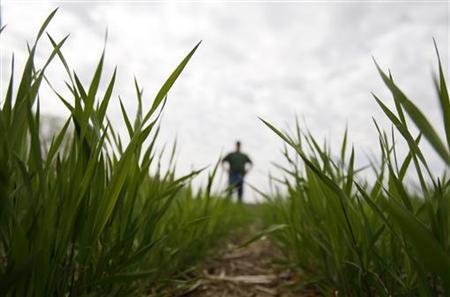Date: 16-Feb-09
Country: US
Author: Julie Steenhuysen

Massive Effort Underway To Save Endangered Seeds Photo:
Carlos Barria
farmer stands in a wheat field in Lincoln, Nebraska, May 5, 2008.
Photo: Carlos Barria
CHICAGO - Farmers and plant breeders around the globe are planting thousands
of endangered seeds as part of an effort to save 100,000 varieties of food
crops from extinction.
In many cases, only a handful of seeds remain from rare varieties of barley,
rice and wheat whose history can be traced back to the Neolithic era, said
Carey Fowler of the Global Crop Diversity Trust, who is speaking on Sunday
at the American Association for the Advancement of Science meeting in
Chicago.
"If we don't do the job right, they are gone," he said in an interview.
The effort, which Fowler thinks is the biggest biological rescue effort ever
undertaken, is aimed at rescuing seeds stored under less-than-optimal
conditions in underfunded seed banks as well as those threatened by human
and natural disasters.
The rescuers hope to preserve seed samples that might provide genetic traits
needed to fight disease or address climate change.
So far, the trust has agreements in place with 49 gene banks in 46 countries
in Africa, Asia and the Americas. The deals cover some 53,000 of the 100,000
varieties that researchers believe are endangered, including rare varieties
of bananas and plantains, potatoes, chickpeas, corn, coconuts, breadfruit,
cowpeas and yams.
Once cultivated, the harvested seeds will be divided into three lots. One
will remain in their native gene bank. Another will be sent to a gene bank
meeting international standards for gene preservation.
And the third, which Fowler terms "the insurance policy," will be placed in
the Svalbard Global Seed Vault in Norway, a $10 million facility in a cavern
near the North Pole designed to keep the seeds frozen for 200 years even if
mechanical refrigeration units fail.
"This is the biological foundation for agriculture," Fowler said. "It is the
raw material that plant breeders use to help agriculture crops adapt to
climate change, to drought or the next pest or disease, or simply be more
productive in terms of yield."
(Editing by Patricia Zengerle)
© Thomson Reuters 2009 All rights reserved
